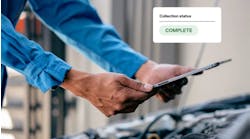ATLANTA — Building the case that battery-powered trucks simply aren’t a viable solution for heavy-duty, over-the-road applications, Hyundai Motor Co. revealed two new concepts at the North American Commercial Vehicle Show.
Essentially, the weight penalties for long-range battery-electric CVs and the trade-off of charging speed versus charging capacity are impractical, concluded Saehoon Kim, Fuel Cell Center head for HMC.
“You have to consider it logically,” Kim said, wrapping up the Hyundai press conference here. “If you see all of the constraints and boundary conditions, you’ll come to the conclusion that we need hydrogen fuel cells in commercial vehicles.”
Operating from that conclusion, HMC introduced the HDC-6 NEPTUNE Concept Class 8 heavy-duty truck, while leading trailer manufacturer Hyundai Translead announced the launch of its new, clean energy refrigerated concept trailer, the HT Nitro ThermoTech. The tractor-trailer combination provides a window into the future of transportation in the U.S. and around the world, and the concepts add product detail to the company’s Fuel Cell Electric Vehicle 2030 Vision for wide-spread deployment of hydrogen-powered fuel cell technology, a team of Hyundai CV representatives explained.
Hyundai bills itself as a global leader in fuel cell technology. In 2013, Hyundai launched the first mass-produced and commercially available fuel cell electric vehicle. In 2018, Hyundai launched the dedicated FCEV, NEXO. In December 2018, Hyundai invested $6.4 billion to accelerate the development of a hydrogen society, looking beyond passenger vehicles.
The HDC-6 NEPTUNE envisions the future of the Class 8 truck in design, in-cab technology and propulsion system. The concept also introduces Hyundai commercial vehicles to the U.S. market. While Hyundai’s commercial offerings are well-known elsewhere, the global vehicle supplier notes this is the first time they have been shown in the US.
“By showing HDC-6 NEPTUNE, the first hydrogen-only concept for HMC’s commercial vehicles, we will start exploring opportunities in the United States commercial vehicle market,” said Edward Lee, head of Hyundai CV business division. “Furthermore, we are willing to work with other partners to pave the way to establish a hydrogen ecosystem for CV.”
Proven technology
The Neptune concept is not to be confused with “the maturity level” of HMC’s fuel cell products already on the road in Asia and in Europe, emphasized Maik Ziegler, CV R&D strategy group head.
“You may have seen a lot of prototype fuel cell trucks at different shows,” Ziegler said. “But let me explain to you the big difference between a show truck and a real working tool.”
He then detailed the development of the first series production of a heavy-duty long-haul FC truck worldwide. Hyundai Hydrogen Mobility, a joint venture between HMC and Switzerland’s H2 Energy, plans to deliver 1,600 fuel cell electric heavy-duty trucks by 2023, marking the entry of the automaker into Europe’s clean mobility commercial vehicle sector. With Hyundai’s commercial vehicle entry to the European market, the U.S. market is an important next phase of the company’s FCEV 2020 vision.
Based on the proven Hyundai Xcient Heavy Duty diesel truck combined with the fuel cell technology from the passenger car Hyudai NEXO, the H2 XCIENT Fuel Cell truck features a new 190 kW hydrogen fuel cell system with two 95 kW fuel cell stacks connected in parallel. It delivers a single-fueling travel range of more approximately 400 km with a fully loaded trailer. It carries seven large hydrogen tanks with a storage capacity of almost 35kg of hydrogen.
The gross combination vehicle weight is 34 tons and a 6X2 variant which is closer to a US configuration is being developed in parallel and will feature a gross combination weight rating of 40 tons. Production is underway and the first trucks will be handed over to customers in early 2020, Ziegler added.
Additionally, HHM has partnered with Hydrospider, a joint venture of H2Energy, Alpiq and Linde, to promote a green hydrogen ecosystem and refueling infrastructure in Switzerland and European countries in the future.
Based on the experience with hydrogen fuel cell vehicles in Korea, a hydrogen refilling station (HRS) needs to service 200 cars a day to be profitable—and a single FCEV is the equivalent of 20 cars.
“With only 10 trucks we have a stable business case for one hydrogen refilling station. These trucks are refueling every day,” Ziegler said. “With 1,600 trucks we have a business case for 160 HRS, enough for a small country like Switzerland. This ensures complete coverage of H2 fueling stations for private fuel cell passenger cars too.
“Again, this truck is designed to earn money and not for marketing purpose,” he continued, and he explained the reason customers want the fuel cell truck rather than a battery-electric vehicle. “First is the refueling time which is obviously much faster for fuel cell vehicles compared to battery—so 15 minutes is an acceptable time for that. But what’s probably even more important is the higher drive range, the higher payload and lower cost.”
He explained that the drive range of battery-electric vehicles depends on the number of batteries stored, and therefore greater range entails greater vehicle weight and reduced payload.
“Fifteen tons of batteries are simply not affordable,” Ziegler said. “Not to be misunderstood: Batteries make absolute sense for low weight and short driving distances, but fuel cells are crucial for heavy duty, long haul commercial vehicles.
“So, with this project, Switzerland is the first country which is changing to a hydrogen society. This is the beginning of a technical revolution—what was vision—is now reality.”
HDC-6 NEPTUNE Concept
One of the key design inspirations for the HDC-6 NEPTUNE Concept was the streamliner railway trains of the mid-20th century, a prime example of Art Deco industrial design, explained Haksoo Ha, head of the CV and interior design group. HDC-6 NEPTUNE employs this inspired function-driven design, with new ways to combine both form and function to create an entirely unique new solution within the commercial vehicle industry, while offering a holistic global approach.
“In the case of most steam locomotives, the firebox and boiler made up most of the mass, leaving very little room for style. Still, some trains from the period managed to become rather distinctive and memorable,” Ha said. “Even though fuel cell components are not easy to package, our designers took up on the challenge of turning them into a valuable source for creativity.”
On HDC-6 NEPTUNE, the design team took packaging challenges and found new ways to combine both form and function. Due to increased cooling requirements, the grill of the concept commercial vehicle is applied as the theme across the entire lower portion of the Hyundai HDC-6 NEPTUNE. This creates a distinctive image while maximizing airflow, Ha explained. The grill concept also integrates the hidden retractable steps. The combination of both cabover and conventional truck formats achieves packaging efficiency and improved ergonomics.
HE also noted that truck size and weight regulations have led to the development of different CV platforms on either side of the Atlantic—but “compatibility is vital” as the world moves towards cost efficiency and parts sharing. The primary purpose of the Hyundai NEPTUNE is to develop a single platform that can be the basis for multiple vehicle configurations.
And the NEPTUNE design draws from both.
“We compared cab-over-engine truck versus conventional trucks for their strengths and shortcomings in order to come with an ideal future truck package with improved ergonomics,” Ha said. “The NEPTUNE marks the beginning of a completely new era, not just for Hyundai, but also for the entire transport industry.
“This is a truck that is built for the future where we venture into new frontiers through innovation and clean sustainable technologies. While revolutionary, the Hyundai Neptune is just a beginning. A large-scale collaborations and advanced research efforts are the key to realize the full transformation of the mobility and logistics industries.”



